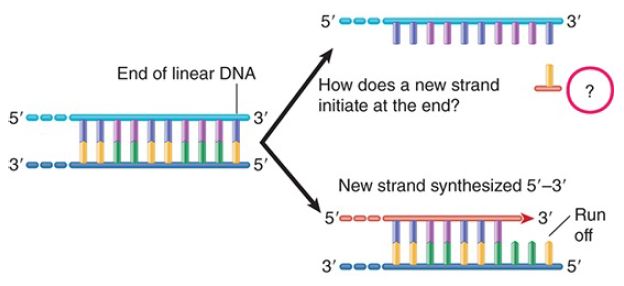


 النبات
النبات
 الحيوان
الحيوان
 الأحياء المجهرية
الأحياء المجهرية
 علم الأمراض
علم الأمراض
 التقانة الإحيائية
التقانة الإحيائية
 التقنية الحيوية المكروبية
التقنية الحيوية المكروبية
 التقنية الحياتية النانوية
التقنية الحياتية النانوية
 علم الأجنة
علم الأجنة
 الأحياء الجزيئي
الأحياء الجزيئي
 علم وظائف الأعضاء
علم وظائف الأعضاء
 الغدد
الغدد
 المضادات الحيوية
المضادات الحيوية|
Read More
Date: 29-12-2015
Date: 17-4-2021
Date: 14-4-2021
|
The Ends of Linear DNA Are a Problem for Replication
KEY CONCEPT
- Special arrangements must be made to replicate the DNA strand with a 5′ end.
None of the replicons examined in this book so far have a linear end: Either they are circular (as in the Escherichia coli genome), or they are part of longer segregation units (as in eukaryotic chromosomes). Linear replicons do occur, though—in some cases as single extrachromosomal units, and at the ends, or telomeres, of eukaryotic chromosomes.
The ability of all known nucleic acid polymerases, DNA or RNA, to proceed only in the 5′→3′ direction poses a problem for synthesizing DNA at the end of a linear replicon. Consider the two parental strands depicted in FIGURE 1. The lower strand presents no problem: It can act as a template to synthesize a daughter strand that runs right up to the end, where presumably the polymerase falls off. To synthesize a complement at the end of the upper strand, however, synthesis must begin right at the very last base, or else this strand would become shorter in successive cycles of replication.

FIGURE .1 Replication could run off the 3′ end of a newly synthesized linear strand, but could it initiate at a 5′ end?
Researchers do not know whether initiation right at the end of a linear DNA is feasible. A polymerase is usually considered as binding at a site surrounding the position at which a base is to be incorporated. Thus, a special mechanism must be employed for replication at the ends of linear replicons. Several types of solutions may be imagined to accommodate the need to copy a terminus:
- The problem can be circumvented by converting a linear replicon into a circular or multimeric molecule. Phages such as T4 or lambda use such mechanisms .
- The DNA might form an unusual structure—for example, by creating a hairpin at the terminus, so that there is no free end.
Formation of a crosslink is involved in replication of the linear mitochondrial DNA of Paramecium.
- Instead of being precisely determined, the end might be variable. Eukaryotic chromosomes might adopt this solution, in which the number of copies of a short repeating unit at the end of the DNA changes . A mechanism to add or remove units makes it unnecessary to replicate right up to the very end.
- A protein can intervene to make initiation possible at the actual terminus. Several linear viral nucleic acids have proteins that are covalently linked to the 5′ terminal base. The best characterized examples are adenovirus DNA, phage Ф29 DNA, and poliovirus RNA.



|
|
|
|
تفوقت في الاختبار على الجميع.. فاكهة "خارقة" في عالم التغذية
|
|
|
|
|
|
|
أمين عام أوبك: النفط الخام والغاز الطبيعي "هبة من الله"
|
|
|
|
|
|
|
قسم شؤون المعارف ينظم دورة عن آليات عمل الفهارس الفنية للموسوعات والكتب لملاكاته
|
|
|